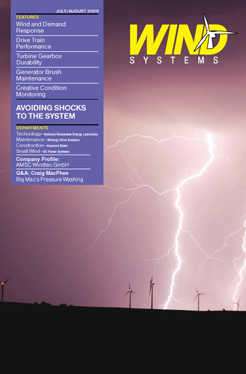Oil is a key life-cycle driver of a gearbox, and proper maintenance is important. The primary purpose of oil is to provide lubrication and protection to rotating mechanical parts such as gears and bearings, and it’s used as a coolant for the gearbox as well. Each of these components’ life-cycle design is based on certain lubricant properties and cleanliness standards of the oil. Most gearboxes are designed with an independent lubrication system; the gearbox lubrication system is designed to circulate oil through the gearbox via a motor-pump combination, cooled via a cooler, and filter particles through filters in the pump. Maintaining quality of the oil by changing typically every two years, replacing filters, maintaining oil cleanliness, proper records, consistency of maintenance, keeping oil in its original state (oil monitoring program), and checking oil flow periodically can impact the life of the gearbox, under normal conditions, more than any other influence. This, coupled with other normal wind turbine maintenance practice, is the best way to ensure extended life.
Oil in a gearbox is designed for wind conditions and is specifically approved for wind turbine use. An important fact to note is not to mix one type of oil with another in a gearbox. In most cases different brands of oil are not compatible with another brand.
Brand: Typically, OEMs have a preference for the brand and type of oil used. This is based on their experiences and testing, as well as gearbox manufacturers. However, the perpetual question of which oil is better is best based on end user experience. Winergy, for example, has at least four different types of oil approved for use in our gearboxes based on several factors. In most cases, however, only one brand/type of oil is approved by an OEM for use in their turbine. In addition, OEMs approve a type of oil so it has consistent use of and performance throughout its supply chain of gearbox manufacturers.
Over a period of time, with a large installed base and a variety of turbines in a given wind farm or in a fleet or portfolio of an end user, the driver for oil specification will be end users. With several types of oil in a wind turbine portfolio it becomes difficult to manage oil changes, track maintenance, and monitor oil integrity. Not to mention the cost of maintaining several types of oil in stock for a fleet with a variety of turbines, as well as a risk in training of staff to ensure the correct type of oil is refilled or replaced and not mixed in a gearbox. Plus there are also economies of scale or leverage in being able to standardize on a brand of oil for its fleet. All these factors and experience in fleets will drive toward end user preference.
Approval: Winergy has an extensive oil qualification program to meet the loads and life-cycle design of gearboxes as specified by the OEM. An oil approval process is costly and can take up to two years based on several factors such as work load, urgency of new oil approval, availability of test stands and, more importantly, the demonstrated benefit, in a similar application, of a new brand of oil.
Oil is tested for paint/primer compatibility, since the oil comes in contact with primer on a gearbox in close proximity to gears and bearings, and also externally during inspections and maintenance. Another area of interaction involves the sealing materials in a gearbox to ensure that they do not deteriorate due to contact with the oil. Also, load tests such as dynamic test under various loads, gear micro-pitting, and scuffing. Non-load testing factors such as filtration, flow/viscosity tests, temperature range, and interaction with moisture are also examined. Bearing life testing is one of the key test criterions for approval of an oil by bearing suppliers to ensure compatibility with the material and assurance of life-cycle calculation validity. Finally, any new brand of oil has to go through field testing to see its impact in real-world application and loads.
Each OEM and gearbox manufacturer, as well as lubrication companies, are sensitive to mixing brands of oil for compatibility and other issues. It is best to follow a very extensive process when replacing oil with a different brand. One of the key elements of this process is a hot flush with the addition of a concentrated cleaning agent in a light viscosity oil through the gearbox to ensure no residue of the previous brand is in the gearing, bearings, or pockets of the gearbox, or in the lubrication/cooling system. The flushing procedure is also important for the purpose of removing contaminants such as sludge from the gearbox and lubrication system. There are companies that specialize in flushing and proper disposal of oil in compliance of various regulatory and local land lease requirements. Consult your OEM and/or gearbox manufacturer if you are contemplating a change in brand of oil. Chances are the brand of oil you want to use may be pre-approved by a manufacturer, or they can share experience based on data or known performance in the field.




































